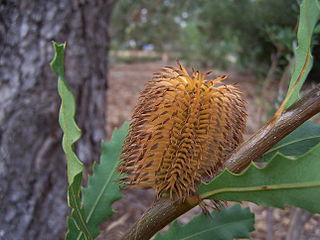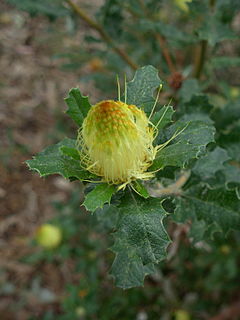
Banksia petiolaris is a rare species of flowering plant in the family Proteaceae native to Western Australia, where it is found in sandy soils in the south coastal regions from Munglinup east to Israelite Bay. It was first described by Victorian state botanist Ferdinand von Mueller in 1864, and no subspecies are recognised. B. petiolaris is one of several closely related species that will all grow as prostrate shrubs, with horizontal stems and thick, leathery upright leaves. Those of this species can be viable for up to 13 years—the longest-lived of any flowering plant recorded. It bears yellow cylindrical flower spikes, known as inflorescences, up to 16 cm high in spring. As the spikes age, they turn grey and develop up to 20 woody seed pods, known as follicles, each.

Banksia chamaephyton, commonly known as the fishbone banksia, is a species of shrub that is endemic to Western Australia. It has prostrate, underground stems, pinnatipartite leaves, cream-coloured and brown flowers arranged in spikes surrounded by hairy bracts. It grows in kwongan near the lower west coast.

Banksia gardneri, commonly known as prostrate banksia, is a species of prostrate shrub that is endemic to Western Australia. It has pinnatipartite or serrated leaves, usually rusty brown flowers, and up to twenty-five elliptical follicles in each fruiting head. It occurs along the west part of the south coast of the state.

Banksia incana, commonly known as the hoary banksia, is a species of shrub that is endemic to the south-west of Western Australia. It has hairy stems, narrow linear leaves, heads of bright yellow flowers and later, up to thirty-six follicles covered with greyish hairs in each head.

Banksia laricina, commonly known as the rose banksia, is a species of shrub that is endemic to southwestern Western Australia. It has crowded, linear leaves with a short point on the tip, golden brown flowers with a bright yellow style and prominent egg-shaped follicles.

Banksia leptophylla is a species of shrub that is endemic to the south-west of Western Australia. It has narrow linear leaves, heads of yellow or pale brown flowers with a yellow or purple style and later, up to eight egg-shaped follicles in each head.

Banksia meisneri, commonly known as Meisner's banksia, is a shrub that is endemic to a small area in the south-west of Western Australia. It has crowded, more or less linear leaves and in winter and spring, spikes of golden brown flowers followed by furry fruit which usually only open after fire.

Banksia nutans, commonly known as nodding banksia, is a species of shrub native to the south coast of Western Australia in the genus Banksia. Growing to a metre (3 ft) tall, it has pale blue-green fine-leaved foliage and unusual purple-brown inflorescences which hang upside down rather than grow upright like most other banksias.

Banksia oreophila, commonly known as the western mountain banksia or mountain banksia, is a species of shrub that is endemic to the south-west of Western Australia. It has glabrous stems, wedge-shaped or narrow egg-shaped leaves with the narrower end towards the base, cylindrical spikes of pale pink to mauve flowers and later, up to twenty follicles in each spike, surrounded by the remains of the flowers. It occurs on slopes and hilltops in the Stirling and Barren Ranges.

Banksia quercifolia, commonly known as the oak-leaved banksia, is a species of shrub that is endemic to the southwestern coast of Western Australia. It has smooth, greenish bark, wavy, wedge-shaped, serrated leaves, yellow, orange or brown flowers in cylindrical spikes, followed by broadly linear follicles surrounded by the remains of the flowers.

Banksia repens, the creeping banksia, is a species of shrub in the plant genus Banksia. It occurs on the south coast of Western Australia from D'Entrecasteaux National Park in the west to Mount Ragged in the east.

Banksia sphaerocarpa, commonly known as the fox banksia or round-fruit banksia, is a species of shrub or tree in the plant genus Banksia. It is generally encountered as a 1–2 m (3.3–6.6 ft) high shrub, and is usually smaller in the north of its range. This species has narrow green leaves, and brownish, orange or yellow round flower spikes which may be seen from January to July. It is widely distributed across the southwest of Western Australia, growing exclusively in sandy soils. It is usually the dominant plant in scrubland or low woodland. It is pollinated by, and is a food source for, birds, mammals, and insects.

Banksia blechnifolia is a species of flowering plant in the genus Banksia found in Western Australia. It was first described by Victorian state botanist Ferdinand von Mueller in 1864, and no subspecies are recognised. It gained its specific name as its leaves are reminiscent of a fern (Blechnum). B. blechnifolia is one of several closely related species that grow as prostrate shrubs, with horizontal stems and leathery, upright leaves. The red-brown flower spikes, known as inflorescences, are up to 20 centimetres (8 in) high and appear from September to November in the Australian spring. As the spikes age, each turns grey and develops as many as 25 woody seed pods, known as follicles.

Banksia micrantha is a species of small shrub that is endemic to the south-west of Western Australia. It is a spreading bush with sharply-pointed linear leaves, pale yellow flower spikes and up to twenty-five follicles surrounded by the remains of the flowers. It was first formally described by Alex George in 1981.

Banksia armata, commonly known as prickly dryandra, is a species of often sprawling shrub that is endemic to Western Australia. It has deeply serrated leaves with sharply pointed lobes and spikes of about 45 to 70 yellow flowers.
Banksia densa is a species of column-like shrub that is endemic to Western Australia. It has deeply serrated to pinnatifid leaves, creamy yellow flowers in heads of up to seventy-five, and hairy follicles.

Banksia erythrocephala is a species of prickly shrub that is endemic to Western Australia. It has erect stems, sharply pointed pinnatifid leaves, cream-coloured and reddish black or all cream-coloured and yellow flowers, and egg-shaped fruit.

Banksia nivea, commonly known as honeypot dryandra, is a species of rounded shrub that is endemic to Western Australia. The Noongar peoples know the plant as bulgalla. It has linear, pinnatipartite leaves with triangular lobes, heads of cream-coloured and orange or red flowers and glabrous, egg-shaped follicles.

Banksia undata, commonly known as urchin dryandra, is a species of shrub that is endemic to the southwest of Western Australia. It has sessile, wedge-shaped, wavy, serrated leaves, pale yellow flowers in heads of between 80 and 160, and later up to eight follicles in each head.
Banksia gardneri var. hiemalis is a variety of Banksia gardneri. It is native to the Southwest Botanical Province of Western Australia. Seeds do not require any treatment, and take around 19 days to germinate.

















